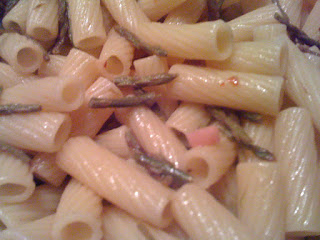Fast forward a lot of years to Spring 2010. We are living in Umbria. We know there are asparagi growing out there in the woods because here and there we think we can see the ferny/thorny looking plants which produce the thin succulent shoots we want to harvest. The hardware stores are full of long forceps-like tools, which both snip and hold the tender spears until they make it into your bag.
I'm not sure what to do or where to look, but I am determined that this will be the spring when I stalk the wild asparagus. Fidelma, my Irish friend, calls to invite me over for an asparagus hunt -- she has been given a gathering lesson by her giardiniere. We put on boots (in case the snakes are waking up from their winter hibernation) and gloves (to protect us from thorns), sling grocery bags over our shoulders, take up our "sticks" and we're off to her 5-acre backyard.
A veteran asparagus picker (this is her second time), Fidelma spots the almost invisible shoots immediately. I stand there squinting into the dappled shade of the underbrush, trying to decide if this is a pursuit that requires sunglasses or not. I don't see a single thing that looks like an asparagus spear.
 We rummage around in the bushes for another hour or so, catching our hair in tree limbs, stumbling over roots, gradually filling up our Sidis bags with wild asparagus. Finally we each have enough to make asparagus pasta for dinner. We stand up and survey the landscape, which stretches in undulating green waves to Todi and, beyond, to Orvieto. Hilltop castles and medieval villages are silhouetted against the sky, where they have stood guard for centuries. No doubt their occupants enjoyed a plate or two of asparagus pasta in the springs of 1210 or 1610, just as we will in 2010. To us, being locavores doesn't only mean eating what's available locally in season. It also allows us to join hands with a tradition that goes back to the beginning of time in these ancient hills.
We rummage around in the bushes for another hour or so, catching our hair in tree limbs, stumbling over roots, gradually filling up our Sidis bags with wild asparagus. Finally we each have enough to make asparagus pasta for dinner. We stand up and survey the landscape, which stretches in undulating green waves to Todi and, beyond, to Orvieto. Hilltop castles and medieval villages are silhouetted against the sky, where they have stood guard for centuries. No doubt their occupants enjoyed a plate or two of asparagus pasta in the springs of 1210 or 1610, just as we will in 2010. To us, being locavores doesn't only mean eating what's available locally in season. It also allows us to join hands with a tradition that goes back to the beginning of time in these ancient hills.We emerge from the woods with muddy boots, dirty jackets, and with treasure. That night, we both cooked asparagus pasta like this:
Use your favorite pasta: spaghetti, tagliatelle, penne, rigatoni.
While the pasta cooks in salted boiling water,
wash and snap off the ends of the asparagus where they break naturally.
Cut or break the remainder of the asparagus into pieces, reserving the tips.
Make a soffritto of olive oil, a little peperoncino (crushed red pepper) and garlic (some people use onion, while others add a bit of chopped bacon); add some white wine.
Add the pieces of asparagus, leaving the tips until the last five minutes, as they cook faster.
Simmer the sauce for about ten minutes or until the pasta is cooked.
Put a few chunks of butter in the bottom of the pasta bowl.
Drain and put the cooked pasta in the bowl.
Pour the asparagus mixture over the pasta and mix together. Add more olive oil if necessary.
Serve.
Eat.
Copyright 2010 Sharri Whiting



No comments:
Post a Comment